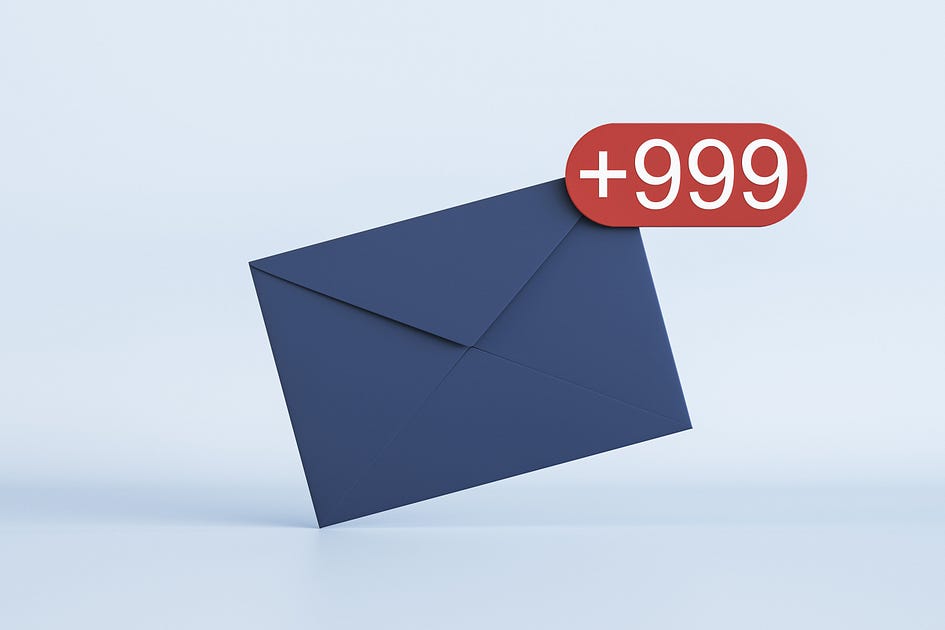Do you ever feel like there’s too much information coming in from all directions for your inbox? It’s easy to get overwhelmed and find yourself lost in the sea of notifications and emails. If you’ve been feeling this way, you aren’t alone. In the modern world, we are constantly bombarded with data and it can be difficult to stay on top of it all.

If you can relate to this, it might be time to re-examine the way you manage your inbox. You could be missing important emails because they are buried in an overflowing inbox. It’s also possible that too much information is causing anxiety or stress because you don’t feel prepared to handle it all.
Today, I will provide some tips on how to declutter your inbox and manage information overload more effectively. You will learn how to identify sources of unnecessary stress and put a system in place for sorting through emails without missing any important ones.
Identifying and Limiting Sources of Overload
When it comes to information overload, the best approach is to identify and limit the sources of information coming in. Think of it as clearing up the stream of data that is flooding your inbox.
So, where can you start? Here are a few tips:
- Unsubscribe from emails that don’t bring value to your life.
- Create folders for different topics and store emails in the appropriate folder for easy access.
- Make sure you set aside a specific amount of time each day for responding to emails so that you don’t end up falling behind on any important messages.
- Follow only accounts that post content you’re interested in — this will help cut down on notifications from sources unrelated to your work or interests.
These tips won’t just help keep your inbox clean but also help reduce stress by making it easier for you to stay on top of all the information coming at you and handle it in an organized manner.
Streamlining Email Subscriptions
So, do you want to prevent that overwhelming feeling when you open your inbox? First, it’s important to take the time to go through all the emails in your inbox and unsubscribe from the ones you don’t need.
Make a conscious effort to unsubscribe from newsletters and other emails that you’re no longer interested in or don’t have time for. You can also create filters that automatically sort all emails based on their sender, subject line, and any other information. This will help keep all of your correspondence organized and easier to manage.
To reduce unwanted promotional emails, click “unsubscribe” when signing up for new products or services. Unroll.me software can also be used to unsubscribe from subscription emails. Setting up a “Do Not Disturb” timeframe prevents email notifications and alerts from accumulating while you are away from your computer.
With these tips and tricks, you’ll be able to easily manage information overload and avoid missing important emails in your inbox!
Setting Up Automatic Filtering and Labeling
If you’re dealing with way too much info overload and your inbox is full to the brim, setting up automatic filtering and labeling can come in really handy. This will help you organize your emails, so important messages don’t slip through the cracks. Here’s how:
Setting up filters
Setting up filters is great because it means that some of your emails are automatically moved away from your main inbox and into appropriate folders. You can set up these rules based on certain keywords in the subject line or recipient. For example, if an email has the keyword ‘invoice’ in the subject line, it’ll automatically redirect to a folder for all things related to invoices. This way, no invoice slips through unnoticed!
Utilizing Labels
Labels are super useful if you want to categorize your emails into different topics or themes — you can even color-code them so they stand out more! Labeling also makes it easier to search for emails on a specific topic. Once you’ve labeled an email, those labels will show up next to any email with similar content. Pretty nifty!
By spending some time setting up automatic filtering and labeling, you can make sure that all of your important emails don’t get lost in the chaos of an overflowing inbox!
Utilizing Advanced Search Tools
When it comes to managing information overload, advanced search tools can be your saving grace. They allow you to quickly and easily search through your inbox and find the emails that you need without having to manually sift through every single message.
Advanced search tools, such as keywords and Boolean searches, help you narrow down your email search. Keyword searches find emails based on subject or body keywords, while Boolean searches combine multiple keywords with logical operators.
With Boolean strings like “product launch & from John”, you can search for emails about a specific topic from a particular sender. You can further refine your search by specifying email types and labels using Gmail’s advanced search. Additionally, saving your searches allows you to repeat them at a later date, which is particularly useful for frequently occurring topics or conversations.
Seeking Automation When Possible
You know the expression, “Work smarter, not harder”? That couldn’t be truer when it comes to managing information overload. Automation can help save time and energy, so seek out options that can help you manage your inbox more efficiently.
One of the biggest areas where automation can help is email notifications. You can set filters that automatically file emails into the appropriate folders. Or you can have emails labeled with tags and labels to make them easier to search through.
Use automated email signatures to avoid typing your contact information every time you send an email. Setting up an auto-responder message for short-term absences is also a good idea. That way, people know immediately that their email has been received and when they should expect a response from you.
Using different email clients, such as MailChimp, Outlook, or Gmail, is beneficial. Features like scheduling emails or setting up reminders help manage your inbox and prioritize tasks, preventing email overload.
Scheduling Email Check-in Times
Sometimes it can feel impossible to keep up with the information overload that comes with emails. Fortunately, there are some simple strategies you can adopt to take back control of your inbox and handle information overload. One such strategy is scheduling email check-in times during your day.
When you set designated times to check your email, it becomes easier to compartmentalize and focus on one task at a time. By reducing distractions caused by constantly checking emails, you can focus more on what’s important at the moment.
Benefits of Scheduling Email Check-in Times
Scheduling email check-in times has several benefits:
- You can be more productive by managing when you read and reply to emails, rather than letting emails dictate the flow of your day
- You can reduce stress from constantly feeling the need to respond immediately
- You won’t miss any important emails by setting specific times for checking your inbox
- You can prioritize tasks more effectively by allocating specific tasks for certain days or times of the day which will help stay organized
Dedicate specific time slots for checking emails to manage them effectively and avoid missing anything important.
Tackling Email Clutter
Reducing clutter in your inbox is crucial for staying organized and managing the email avalanche. It only takes about 15 minutes a day to get your email marketing in proper order. One effective approach is to regularly set aside time to review and clear out unnecessary emails. This may involve deleting old emails, unsubscribing from newsletters you no longer read or archiving messages that don’t require further action.
Another excellent tactic for tackling email clutter is to use the “Two-Minute Rule.” This principle, based on David Allen’s Getting Things Done methodology, suggests that if an email requires less than two minutes to read and respond to, you should do so immediately rather than leaving it to accumulate in your inbox.
Lastly, consider implementing the “Inbox Zero” approach, which involves attending to every email in your inbox by the end of each day. By addressing each message and filing it accordingly, you’ll maintain a clean and clutter-free inbox.
Information overload can be a daunting challenge to take on, but with the right tools, tactics, and practices you can eliminate a lot of unnecessary stress. With the right strategy, you can reclaim your time and take back control of your inbox.
Think of your inbox as a garden, if you don’t weed out the bad emails, you’ll be overgrown and overwhelmed. Prioritize what is important, unsubscribe from emails you don’t need, and make sure you are only open and focused on emails that will provide you with value.
Decluttering your inbox can be a great way to manage information overload and make sure that you don’t miss any important emails. Take back control of your inbox and be mindful of what information is making its way into it.




